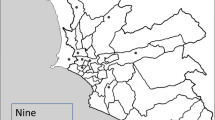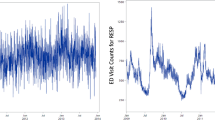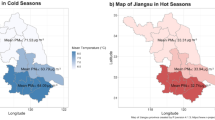Abstract
Background
The health effects of fine particulate matter (PM2.5) may be worse at higher temperatures.
Objective
To investigate temperature’s effect on PM2.5-mortality/morbidity associations in Lima, Peru.
Methods
Time-series regressions relating PM2.5 and temperature to mortality and emergency room (ER) visits during 2010–2016. Daily PM2.5 levels (assigned to 40 Lima districts) and daily maximum temperature (Lima-wide) were estimated based on ground monitors, remote sensing, and modeling. We analyzed all-cause, cardiovascular (ICD codes I00-I99), and respiratory (ICD codes J00-J99) mortality, and cardiovascular and respiratory causes for ER visits.
Results
The average PM2.5 concentration was 20.9 µg/m3 (IQR 17.5–23.5). The mean daily maximum temperature was 23.8 °C (IQR 20.8–26.9). PM2.5’s effect on all-cause, respiratory, and circulatory disease mortality was significantly (p < 0.05) stronger at temperatures above the maximum temperature median. The rate ratios per increase of 10 µg/m3 of PM2.5 for all cause, respiratory, and circulatory mortality respectively were 1.03 (1.00–1.06), 1.04 (0.98–1.10), and 1.04 (0.98–1.10) at temperatures below the median, vs. 1.08 (1.04–1.12), 1.11 (1.03–1.19), and 1.14 (1.05–1.25) when temperatures were above the median. Results were analogous for ER visits for respiratory but not circulatory disease.
Significance
Results strengthen the evidence that air pollution may be more dangerous when temperatures are higher.
Impact
Our data contribute to a growing body of literature which indicates that the damaging effects of PM2.5 may be worse at higher temperature, adding new evidence from Lima, Peru.
This is a preview of subscription content, access via your institution
Access options
Subscribe to this journal
Receive 6 print issues and online access
$259.00 per year
only $43.17 per issue
Buy this article
- Purchase on Springer Link
- Instant access to full article PDF
Prices may be subject to local taxes which are calculated during checkout




Similar content being viewed by others
References
Chen F, Fan Z, Qiao Z, Cui Y, Zhang M, Zhao X, et al. Does temperature modify the effect of PM10 on mortality? A systematic review and meta-analysis. Environ Pollut. 2017;224:326–35.
Karagulian F, Belis CA, Dora CFC, Prüss-Ustün AM, Bonjour S, Adair-Rohani H, et al. Contributions to cities’ ambient particulate matter (PM): a systematic review of local source contributions at global level. Atmos Environ. 2015;120:475–83.
Gouveia N, Kephart JL, Dronova I, McClure L, Granados JT, Betancourt RM, et al. Ambient fine particulate matter in Latin American cities: Levels, population exposure, and associated urban factors. Sci Tot Env. 2021;772:145035.
Chen K, Wolf K, Breitner S, Gasparrini A, Stafoggia M, Samoli E, et al. Two-way effect modifications of air pollution and air temperature on total natural and cardiovascular mortality in eight European urban areas. Environ Int. 2018;116:186–96.
Liu C, Chen R, Sera F, Vicedo-Cabrera AM, Guo Y, Tong S, et al. Ambient Particulate Air Pollution and Daily Mortality in 652 Cities. N. Engl J Med. 2019;381:705–15.
Anenberg SC, Haines S, Wang E, Nassikas N, Kinney PL. Synergistic health effects of air pollution, temperature, and pollen exposure: a systematic review of epidemiological evidence. Environ Health. 2020;19:130.
Tapia V, Steenland K, Vu B, Liu Y, Vásquez V, Gonzales G. PM2.5 exposure on daily cardio-respiratory mortality in Lima, Peru, from 2010 to 2016. Environ Health. 2020a;19:63.
Tapia V, Steenland K, Sarnat SE, Vu B, Liu Y, Sánchez-Ccoyllo O, et al. Time-series analysis of ambient PM(2.5) and cardiorespiratory emergency room visits in Lima, Peru during 2010-2016. J Expo Sci Environ Epidemiol. 2020b;30:680–8.
Vu B, Sánchez O, Bi J, Qingyang Xiao Q, Hansel N, Checkley W, et al. Developing advanced PM2.5 exposure models in Lima, Peru. Remote Sens. 2019;11:641.
Sarnat SE, Sarnat JA, Mulholland J, Isakov V, Özkaynak H, Chang HH, et al. Application of alternative spatiotemporal metrics of ambient air pollution exposure in a time-series epidemiological study in Atlanta. J Expo Sci Environ Epidemiol. 2013;23:593–605.
Harrell FE Jr, Lee KL, Pollock BG. Regression models in clinical studies: determining relationships between predictors and response. J Natl Cancer Inst. 1988;80:1198–202.
Yitshak-Sade M, Bobb J, Schwartz J, Kloog I, Zanobetti A. The association between short and long-term exposure to PM2.5 and temperature and hospital admissions in New England and the synergistic effect of the short-term exposure. Sci Tot Env. 2018;639:868–75.
Hsu W, Hwang S, Kinney P, Lin S. Seasonal and temperature modifications of the association between fine particulate air pollution and cardiovascular hospitalization in New York state. Sci Tot Env. 2017;578:626–32.
Lokotola CL, Wright CY, Wichmann J. Temperature as a modifier of the effects of air pollution on cardiovascular disease hospital admissions in Cape Town, South Africa. Environ Sci Pollut. 2020;27:16677–85.
Bergmann S, Li B, Pilot E, Chen R, Want B, Yang J. Effect modification of the short-term effects of air pollution on morbidity by season: a systematic review and meta-analysis. Sci Tot Env. 2020;716:136985.
Acknowledgements
Vilma Tapia and Vanessa Vasquez kindly provided the hospital data on emergency room visits, and the mortality data, as part of our collaborative work on the GeoHealth Hub in Peru. Temperature data came from public information available from SENAMHI (National Meteorology and Hydrology Service of Peru), a Peruvian government agency, while hospital data came from MINSA (Ministry of Health), and we thank both these agencies for their help.
Funding
The present study was founded by the National Institutes of Health (Fogarty Program) [Grant U01TW010107, 1/2 Regional GEOHealth Hub centered in Peru]. NS is supported by the NIEHS-funded HERCULES Center (P30ES019776).
Author information
Authors and Affiliations
Contributions
KS, BV and NS contributed to the writing of the paper. KS conducted the analyses. BV helped with data management.
Corresponding author
Ethics declarations
Competing interests
The authors declare no competing interests.
Additional information
Publisher’s note Springer Nature remains neutral with regard to jurisdictional claims in published maps and institutional affiliations.
Supplementary information
Rights and permissions
About this article
Cite this article
Steenland, K., Vu, B. & Scovronick, N. Effect modification by maximum temperature of the association between PM2.5 and short-term cardiorespiratory mortality and emergency room visits in Lima, Peru, 2010–2016. J Expo Sci Environ Epidemiol 32, 590–595 (2022). https://doi.org/10.1038/s41370-021-00393-7
Received:
Revised:
Accepted:
Published:
Issue Date:
DOI: https://doi.org/10.1038/s41370-021-00393-7
Keywords
This article is cited by
-
City-level impact of extreme temperatures and mortality in Latin America
Nature Medicine (2022)
-
Exposure science perspective on disaster preparedness and resilience
Journal of Exposure Science & Environmental Epidemiology (2021)



